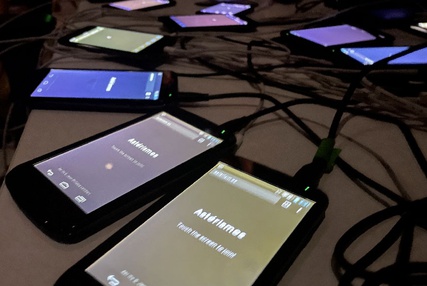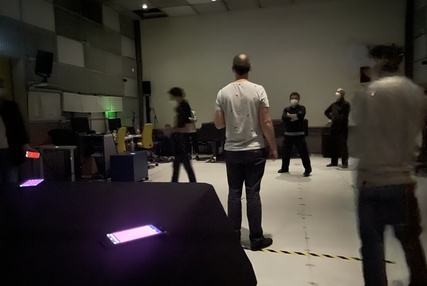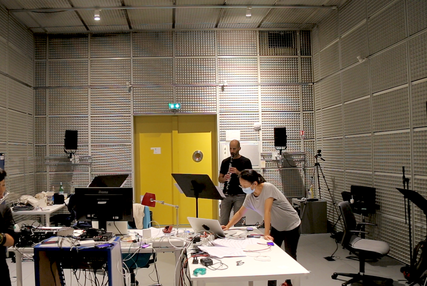L’une des conditions sine qua non pour l’acceptation d’un projet de résidence en recherche artistique à l’Ircam est que les enjeux technologiques dudit projet entrent en résonance avec les préoccupations des équipes de recherche. Porté par la compositrice Aki Ito et le chercheur Jean-Philippe Lambert, le projet « Astérismes » ne fait pas exception et s’inscrit dans le cadre des travaux de l’équipe Interaction son musique mouvement, dirigée par Frédéric Bevilacqua, et particulièrement ceux de Benjamin Matuszewski.
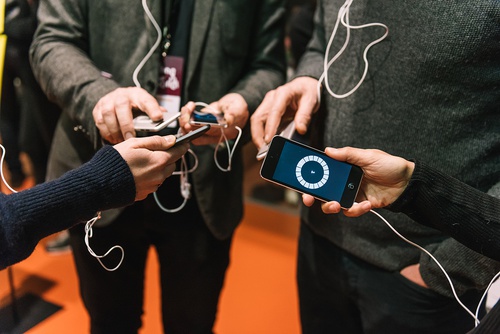 Voilà quelques années que l’équipe Interaction son musique mouvement (ISMM) explore différents types d’interaction sonore collective. C’est-à-dire faire interagir plusieurs agents (personnes, terminaux, haut-parleur) par les gestes et le son. C’est ainsi que l’équipe expérimente notamment sur la captation et le suivi de gestes. Dans le cas d’« Astérismes », l’enjeu est de faire interagir, dans un même lieu, différents objets sonores, dotés d’interfaces variées. Le projet s’appuie en partie sur une connaissance agrégée dans le cadre du projet de recherche CoSiMa (Collaborative Situated Media), dont l’objet était de développer des technologies de diffusion sonore sur la base d’outils web, en utilisant des réseaux locaux – comme c’est le cas pour « Astérismes » –, qui ne passent nullement par Internet. Ces outils web sont évidemment présents dans tous les téléphones portables :
Voilà quelques années que l’équipe Interaction son musique mouvement (ISMM) explore différents types d’interaction sonore collective. C’est-à-dire faire interagir plusieurs agents (personnes, terminaux, haut-parleur) par les gestes et le son. C’est ainsi que l’équipe expérimente notamment sur la captation et le suivi de gestes. Dans le cas d’« Astérismes », l’enjeu est de faire interagir, dans un même lieu, différents objets sonores, dotés d’interfaces variées. Le projet s’appuie en partie sur une connaissance agrégée dans le cadre du projet de recherche CoSiMa (Collaborative Situated Media), dont l’objet était de développer des technologies de diffusion sonore sur la base d’outils web, en utilisant des réseaux locaux – comme c’est le cas pour « Astérismes » –, qui ne passent nullement par Internet. Ces outils web sont évidemment présents dans tous les téléphones portables :
« Nous réutilisons l’infrastructure matérielle et logicielle des téléphones pour mettre en place un système d’écoute interactive, en temps réel, entre différentes personnes dans un même lieu, dit Frédéric Bevilacqua. Les téléphones sont en quelque sorte utilisés comme des haut-parleurs, jamais neutres car limités en fréquence et en puissance, mais qui sont mobiles et peuvent être déployés à grande échelle. »
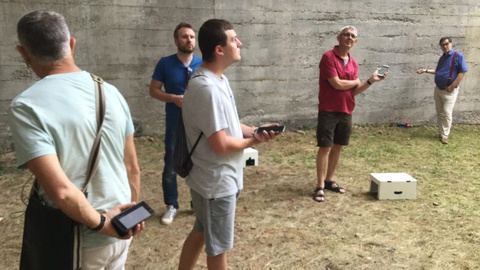
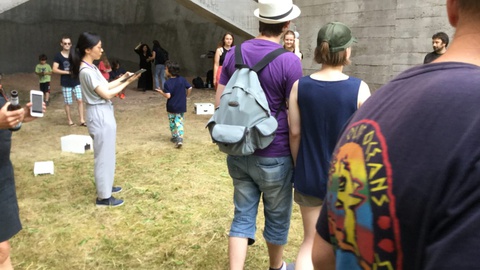
Résidence Astérismes, Réservoir Festival, La forêt-Noire en Allemagne, 2019 © Aki Ito et Jean-Philippe Lambert
L’un des principaux DÉFIS, bien sûr, est de mettre au point un outil centralisateur, une sorte de console de mixage, qui permet de gérer tous les téléphones en même temps pour distribuer et diffuser les sons selon le discours musical. À cet égard, « Astérismes » s’appuie sur les recherches de Benjamin Matuszewski, et notamment de l’environnement soundworks auquel il travaille : « Soundworks, explique le chercheur, c’est un cadre logiciel qui permet de contrôler la diffusion d’un ensemble de sons distribués. Un des enjeux importants ici est de mettre au point une interface de travail, un « workflow » ou environnement de travail, pour la compositrice, afin de gérer le plus simplement, le plus finement et de la manière la plus fluide possible, le dispositif de diffusion en réseau – un dispositif hétéroclite (car composé de différents types de téléphone) qui, de surcroît, est très dynamique (les gens peuvent se connecter et se déconnecter à leur gré).
La résidence d’Aki et Jean-Philippe est très précieuse pour nous, puisqu’elle permet d’avoir un retour sur l’outil que nous développons, sur ce qui fonctionne et ce qui ne fonctionne pas, ce qui nous aide à peaufiner certains détails, et à bâtir un outil plus solide et plus fluide.
Par ailleurs, on s’aperçoit parfois grâce à l’artistique qu’il y a des choses qu’on ne sait pas faire, mais qu’on pourra essayer de développer. Ici, on a buté sur toute sorte de problèmes à commencer par un point essentiel pour certains types de musique : la synchronisation précise des sources sonores en réseau, avec des enjeux de latences variables selon les téléphones et les marques. »

Nous verrons dans les épisodes suivants comment ces problèmes ont été partiellement ou complètement résolus, ou tout simplement contournés.
Photo 1 : Soirée Daphni à l'Ircam, 2019 © Ircam - Centre Pompidou, photo : Aliocha Boi



 Voilà quelques années que l’équipe Interaction son musique mouvement (ISMM) explore différents types d’interaction sonore collective. C’est-à-dire faire interagir plusieurs agents (personnes, terminaux, haut-parleur) par les gestes et le son. C’est ainsi que l’équipe expérimente notamment sur la captation et le suivi de gestes. Dans le cas d’« Astérismes », l’enjeu est de faire interagir, dans un même lieu, différents objets sonores, dotés d’interfaces variées. Le projet s’appuie en partie sur une connaissance agrégée dans le cadre du
Voilà quelques années que l’équipe Interaction son musique mouvement (ISMM) explore différents types d’interaction sonore collective. C’est-à-dire faire interagir plusieurs agents (personnes, terminaux, haut-parleur) par les gestes et le son. C’est ainsi que l’équipe expérimente notamment sur la captation et le suivi de gestes. Dans le cas d’« Astérismes », l’enjeu est de faire interagir, dans un même lieu, différents objets sonores, dotés d’interfaces variées. Le projet s’appuie en partie sur une connaissance agrégée dans le cadre du 

